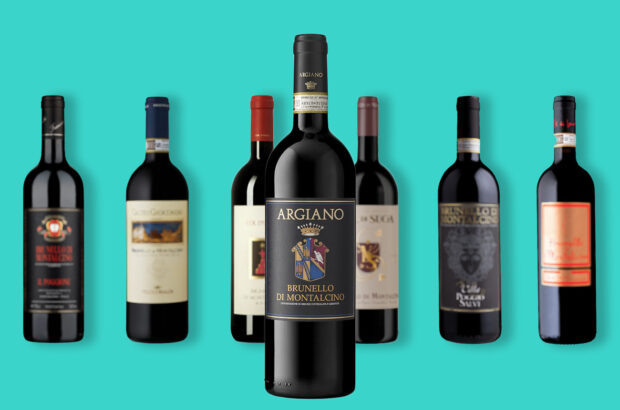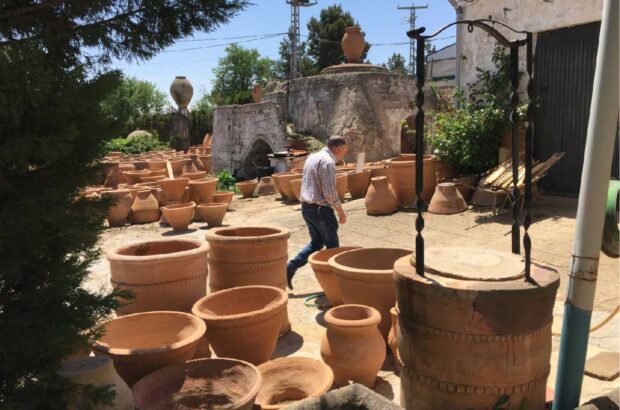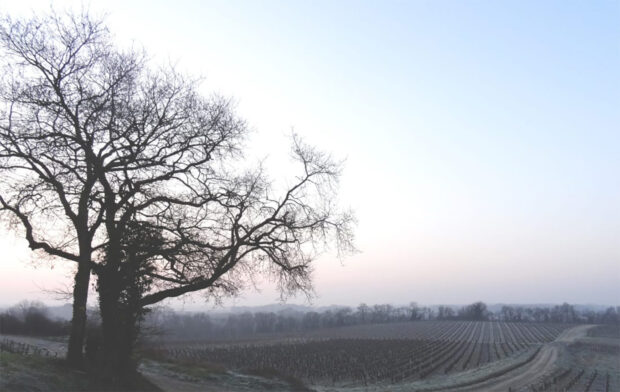Dick Ward cuts a dapper figure in the sweaty, slightly tipsy atmosphere of the London International Wine and Spirits Fair. With his matinée-idol looks, neat bow tie and well-ironed shirt, he looks more like a high-school history teacher than a winemaker.There is something of the academic about Dr Dick, as he styles himself in his email address (‘it’s an honorary title, which I got when I used to go on at length with scientific explanations for things’). After all, he named his Napa winery after eminent literary Victorian George Saintsbury. And his dedication to Pinot Noir – perhaps the most ancient variety in the world, and certainly the most finicky – reminds you of an aesthete championing a difficult author. Pinot is James Joyce while Cabernet Sauvignon is Dickens, perhaps. Both sell well but one is slightly easier to understand. As Ward says of the big, broad, extracted, rich Cabernets, ‘they are tremendously obvious, and are easily recognisable as something’.
But – to stretch the metaphor – Pinot is fast moving out of the literature section and onto the bestsellers’ shelves. Things are looking good, and Saintsbury is in prime position to reap the benefits. It’s just bought 180ha (hectares) of Carneros land with a view to bringing 80 to 100% of its production in-house, and Ward feels as if the world’s at his feet. ‘We’re masters of our own destiny,’ he says. ‘The new land will increase our vineyard acreage by 150%. The greatest potential for making better wine is in the vineyard, so that’s where we’re focusing our attention.’Dick Ward and his business partner David Graves met while studying oenology at UC Davis in 1976. They started Saintsbury, buying in grapes to make their first wine in 1981, and first planted in 1986. According to Stephen Brook, author of The Wines of California, they planned to limit production to 25,000 cases but enjoyed such success they upped production to some 40,000 cases of Pinot and about 15,000 Chardonnay. Brook describes Saintsbury as ‘surely the best of the Carneros-based wineries’, and Decanter consultant editor Steven Spurrier considers their Reserve Pinot ‘one of the first to show pure Carneros fruit – the Reserve is always more complex and profound, and to me more Burgundian.’ The Chardonnay is always well received, and there is a fine Pinot Noir rosé – the Vincent Vin Gris.
Ward and Graves
Joined 16 years ago by winemaker Byron Kosuge – shortly to leave Saintsbury – Ward and Graves have followed a path they set out on in the mid-1970s. ‘What drew us together? We were full of ourselves, irreverent, and we thought we could do some interesting things.’Now he is master of his destiny, and with good reason. The great grape of Burgundy has never been more popular. ‘There is a huge demand for Pinot,’ says Ward, ‘and there are a lot of people who haven’t been in the Pinot Noir business who are now thinking “That’s pretty good. Look at the wines that Saintsbury is making, or (Russian River’s) Williams Selyem. We’d like to be able to do that”.’ Where others might be nervous that a Pinot bandwagon could compromise quality, Ward is delighted. ‘A lot of the Pinot Noir in Carneros has been grown by sparkling wine divisions. They built large facilities with hundreds of acres of vineyards, and the market for California sparkling never materialised. So now Codorníu is being recreated as Artesa, Domaine Carneros (the US offshoot of Champagne Taittinger) built a 100,000-case facility but never managed to do more than 25,000 cases – and they’re all getting into still Pinot.
‘The exciting thing in America about Pinot Noir is that we’ve finally reached critical mass. The amount of good wines for a series of years has created lots of new Pinot drinkers.’This happy new army of Pinot drinkers needs guidance, and that, of course, will come in a large part from the ubiquitous scores of Robert Parker. What does he feel about the potent influence of the most powerful wine critic in the world? ‘I feel he has a stronger influence over Cabernet Sauvignon. He’s got a tremendous palate and he’s done a great service, but he’s also done a disservice. I think that by writing in such a romantic and wonderfully inflammatory way he makes people focus on these extracted rare wines. Then they try to join the bandwagon of super-rich, super-ripe, super-extracted wines, and they can lose sight of the fact that some are pretty difficult to drink at times. There are thousands of wines that are wonderful examples of their type in terms of concentration, flavour and balance. I think we have gone a bit overboard.’ But like most American winemakers, Ward admits ‘Parkerisation’ is inevitable. ‘I think maybe we are moving towards more Parkerised Pinot Noir. Maybe Saintsbury’s Brown Ranch is one of those. When these wines are at their most successful they are really fantastic. In less successful vintages they are perhaps more difficult. They have all of that richness and ripeness and super-concentration, but they aren’t quite as successful in elegance and finesse, or purity of varietal character.’ Ward is quick to point out that Brown Ranch is very different to the Reserve. ‘Brown Ranch can be very ripe and concentrated, and also slightly upmarket in price. They are different, but in 1999, which was a wonderfully cool growing season, the two were very close together in quality.’ Elegance and finesse are the twin grails that Ward constantly refers to. He isn’t a great fan of Californian Cabernet in its most Parkerised form, considering it ‘fatiguing to drink’, but he envies its power. ‘The challenge is to get power with finesse and elegance. The greatest Italian and French wines achieve it, and it is possible in California, but it’s a significant challenge.’
Carneros Pinot
There is another challenge. Ward is not only aiming to produce great California Pinot, but great Carneros Pinot. With prime plantable land in Napa changing hands for upwards of $247,000 per ha, expansion is difficult, but there is no thought of buying elsewhere. ‘It would be exciting to go to Sonoma, or to Oregon, or New Zealand, but the fact is there are still many challenges open to us without going out of Carneros.’ It would indeed be exciting to work the Saintsbury magic in other parts of the world, and there must be many who are wondering if they can buy into its success. Ward won’t be drawn on this, except to say that there have been offers, but they are unlikely to be signing any contracts. ‘As soon as somebody makes a large investment in your company they want to mould it into something that fits them,’ he says. He likes the idea of a joint venture along the lines of Robert Mondavi’s tie-up with Rosemount, in which Tim Mondavi and the Australian company’s Philip Shaw have joined forces to make two premium wines, but ‘nobody’s come up to us yet and said “Hey, let’s do this”.’ Speculating who might pop that question is fruitless. Maybe the Burgundians, whose myriad communes make their labels difficult for even the French to follow, might want a crash course in marketing. Does Ward have any advice on how to sell Pinot Noir? ‘The advice for any producer is to make delicious wines that people can afford to drink at any level.’ And also label the wines so that people understand exactly what they are drinking? ‘Exactly. For us the excitement about selling our wine is we don’t spend much money on marketing. We let the wines speak for themselves. It means you never have to say you’re sorry – you haven’t convinced them to buy by promotion.’ While Ward is certain that Pinot will never saturate the market – ‘it’s insulated from fashion because you can’t really overplant it. There are too few places it will decently grow’ – he is considering other varieties. ‘Carneros is a spectacularly good place to grow Rhône varieties. I think Mourvèdre is the Cabernet end of the spectrum, Grenache is the Pinot Noir end, and Syrah is in the middle, so we would go with Syrah and Grenache. It wouldn’t be Saintsbury though. Maybe a new brand.’
Keep your eyes open.
Top Pinot Noir wines outside Burgundy – Updated
About Dick Ward
Dick Ward seems totally at home in his profession and his environment. Married to (his second wife) Linda Rieff, executive director of the Napa Valley Vintners Association, he has two children, now in their 20s, from his first marriage. But neither his daughter Philippa nor his son Trent, studying finance, are following their dad’s calling. In his spare time he gardens, reads and collects art. Another love is architecture, particularly the classic Californian style, and he has recently finished a project to renovate an old farmhouse.












